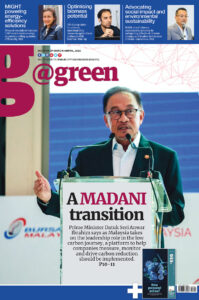Malaysia has well-documented track record of energy-efficient office buildings dating back 17 years
While the National Energy Awards celebrate the achievements of energy-efficient and green buildings, the real story is: “Why are there so relatively few of them?”
In a world where climate change has been identified as an existential threat to humanity requiring imminent action of halving greenhouse gas emissions by 2030, and where the building sector has been identified as the sector with the most considerable potential for cheap greenhouse gas emission savings, the conclusion is clear: Energy-efficient and green buildings should be the norm and not the exception.
During her keynote address at the Malaysian National Energy Awards 2019, the (former) Minister of Energy, Science, Technology, Environment and Climate Change (MESTECC), Yeo Bee Yin, stated that “energy efficiency is the lowest hanging fruit”.
Yet, a concerted push for widespread adoption of energy efficiency in the building sector is still outstanding, with a meagre 0.4 per cent national greenhouse gas reduction attributed to green buildings in 2019. The main reasons are a lack of comprehensive energy efficiency legislation, a lack of awareness, and not paying the actual energy cost.
Malaysia already has a well-documented track record of energy-efficient office buildings dating back 17 years.
The first successful case study was the Ministry of Energy’s headquarters, the so-called Low Energy Office (LEO) building, with came into operation in 2004 and achieved more than 50 per cent energy savings.
The energy comparison was made by obtaining the energy bills of the neighbouring eight office buildings, all built around the same time in the newly-established government capital of Putrajaya.
Equally important, the LEO building demonstrated that energy-efficient buildings are not expensive to build and have a reasonable payback time of five years.
By conducting two separate building tenders, one with and one without the energy-efficient design features, the LEO building demonstrated a construction cost increase of just five per cent to cut the energy consumption in half.
Today, those figures have dropped to about three per cent additional construction cost to achieve 50 per cent energy savings with a payback time of just three years.
This is consistent with the findings from Malaysia’s first green building certification body, Green Building Index (GBI). Figures were tabulated from its database of 500 green buildings (2009-19) and found that the additional construction cost of green buildings was found to be between 1.1-3.8 per cent for primary (Certified) to highly (Gold) certified structure, respectively.
GBI also found that for the highest level of green-certified buildings (Platinum), the additional construction cost figure was 5.1 per cent, but was based on insufficient data.
GBI found the fraction of the additional construction cost attributed to improving the energy efficiency is 44.5 per cent and 63.4 per cent for residential and non-residential buildings, respectively. The operational savings of green-certified buildings are on average RM803,000 per year, or RM1.60 per square foot, with a return of investment of fewer than three years.
Once the other benefits from energy-efficient and green buildings are factored in – improved indoor environment with pleasant daylighting and clean air to breathe that makes the building occupants healthier, less sick and more productive at work – the payback time drops to less than one year.
With such an excellent economic case, it is no wonder that countries worldwide are making energy-efficient and green buildings mandatory by law.
In the EU, for example, the Energy Performance of Buildings Directive (EPBD) requires all new buildings to be Nearly Zero Energy Buildings (NZEB) by Dec 31, 2020.
Moreover, mandatory energy labelling of buildings has already been a reality for more than 10 years. The EU directive requires that the sale or rent facilities shall include the advertisement’s building energy label.
The operational energy expenditure for buildings becomes visible and, therefore, also one of the decisive factors for sale and rental.
In South-East Asia, Singapore is leading the way for mandatory energy efficiency for the entire building stock with its newly announced “80-80-80 in 2030” Masterplan, which requires:
• 80 per cent of whole building stock to be certified green by 2030
• 80 per cent of new buildings to be super low energy by 2030, i.e. by achieving at least a 60 per cent improvement in energy efficiency compared to 2005 levels
• 80 per cent improvement in energy efficiency, namely for best-in-class green buildings to see an 80 per cent improvement in energy efficiency, compared to 2005 levels (up from 60 per cent)
Malaysia has already taken an essential step towards the energy labelling of buildings. The Malaysian government should be lauded by taking the lead, namely by requiring the government building to undergo mandatory energy labelling.
The scheme is first being rolled out for office buildings, while more complex facilities, such as government hospitals, will follow. Moreover, the Green Building Index (GBI) has also begun to list the building energy intensity (BEI) figure separately on their certificate:
The Malaysian government’s effort to push for mandatory energy labelling for government buildings should be lauded and encouraged – and eventually legislated – on a national scale.
The Malaysian parliament is slated to review and hopefully approve the much-anticipated Energy Efficiency and Conservation Act (EECA) by Q3 2021.
The Act will regulate comprehensive building energy codes, building energy labelling and electrical appliance energy performance standards.
Along with this Act, new requirements will be outlined to provide comprehensive measures to promote sustainable energy consumption, including target setting, communication, and education.
The EECA is projected to save the Malaysian government nearly RM47 billion by 2030. Such initiatives should go hand in hand with mandatory green building certification beyond the narrow focus on energy efficiency by setting targets for low-carbon building materials and occupant health and well-being.
Level playing field
It is time to address the elephant in the room: Energy pricing. Currently, the actual cost of energy is not reflected in the consumer price.
The application of a “polluters pay” principle, where the harm caused by pollution is factored into the price, is rarely practised in Asia. On the contrary, dirty fossil fuels like coal and petrol are often subsidised.
This results in an uneven playing field. Energy-efficient solutions and renewable energy alternatives have difficulty competing because fossil fuels are artificially underpriced, or what economists denote as a post-tax subsidy.
Case in point, the price of coal (US$4.4 per GJ) matches the supply cost in most countries, but coal should be more than double once the cost of pollution is accounted for.
The environmental cost of coal most stems from global warming and the adverse public health effects from air pollution. For Thailand and Singapore, the price of coal should be about 500 per cent and 1,200 per cent higher, respectively, according to the actual cost figures by IMF (2017).
For the vehicle fuels diesel and gasoline, a similar scenario of underpricing emerges. A significant portion of these fuels’ hidden cost comes from “vehicle externalities”, namely from traffic congestion and traffic accidents.
The consumer price of gasoline and diesel for vehicles should be roughly twice and three times higher, respectively. It is also worth noting that both diesel and petrol are given direct subsidies for Malaysia and Indonesia, as the consumer price is lower than the supply cost.
The direct fossil fuel subsidies in emerging and developing nations in Asia is US$70 billion per year. However, once the hidden costs are taken into account, the total fossil fuel subsidies in Asia add up to a whopping US$2,311 billion per year or 13.2 per cent of the GDP.
For comparison, approximately the same budget is spent by the governments on the educational sector.
The fossil fuel subsidies should be quickly phased out to level the playing field, not just in Asia but also across the world. The environmental gains by doing so would in Asia include a 30 per cent drop in CO2 emissions from fossil fuels and a 50 per cent drop in deaths caused by air pollution from fossil fuels.
According to climate economist Nicholas Stern, fossil fuel’s environmental cost is much higher once the long-term effects of climate change are fully accounted for. Hence, make a case for getting rid of the fossil fuel subsidies as soon as possible stronger. It is time to follow Singapore’s example of introducing carbon taxation on energy.
Carbon taxation introduced as a “Fee and Dividend” scheme
The intelligent thing about carbon taxation, or CO2 taxation, is that prices across the board will be affected proportionally to their individual carbon footprint.
As such, carbon taxation is universally applied fairly and robustly and is not prone to special interest lobbyism. Carbon Border Tax Adjustment (CBTA) can be imposed on imported goods from countries without carbon taxation to maintain businesses’ competitiveness.
A commonly heard argument against implementing a carbon tax – or environmental taxation in general – will hurt low-income families by reducing their disposable income.
The opposite is true if carbon taxation is implemented as a simple “Fee and Dividend” scheme. Championed by the Citizens’ Climate Lobby, the monthly national carbon tax revenue is paid out as a monthly dividend in equal proportions to all citizens in this scheme.
Low-income families will typically experience a net economic gain, as the monthly dividend payout likely will be significantly higher than their monthly carbon taxes expenses due to the lower consumption and spending power of low-income families.
In other words, if applied along the lines of the Fee and Dividend scheme, carbon taxation can gain instant approval and popularity among the low-income segment of the population and become a political win.
Wooden Construction
As buildings become more energy-efficient, the greenhouse gas emissions associated with building materials must also be addressed.
Trees are one of nature’s most effective ways of removing CO2. By using sustainably forested wood for construction, our built environment can effectively become carbon storage.
Wooden products such as glulam, cross-laminated timber and mass engineered wood can be used to partially replace conventional structural elements made from concrete and/or steel, both of which have a high carbon footprint.
For the Eunoia Junior College, Singapore, glulam beams replaced the conventional concrete beams, which had the advantage of faster and lighter construction without increasing construction costs.
Most of the structural wood technologies are imported from temperate climates. Local structural wood solutions based on Asian tree species will be developed for the regional market.
Action, please!
Malaysian buildings have lots of potential for energy efficiency improvements, both in operation and in the choice of low-carbon building materials.
Not only is there a good business case to be made for doing so, but the existential threat posed by climate change demands a rapidly low-carbon transformation of the building sector.
Interestingly, there is widespread public support for immediate action on climate change. In December 2020, a global opinion poll was conducted by UNDP among 1.2 million respondents in 50 counties.
The poll found that two-thirds of the world’s population denotes climate change as a “global emergency” and want “urgent action”.
So let us not hesitate any longer and, through a concerted all-hands-on-deck effort, start plucking the “lowest hanging fruits”, aka by mainstreaming energy-efficient and green buildings. — @green








